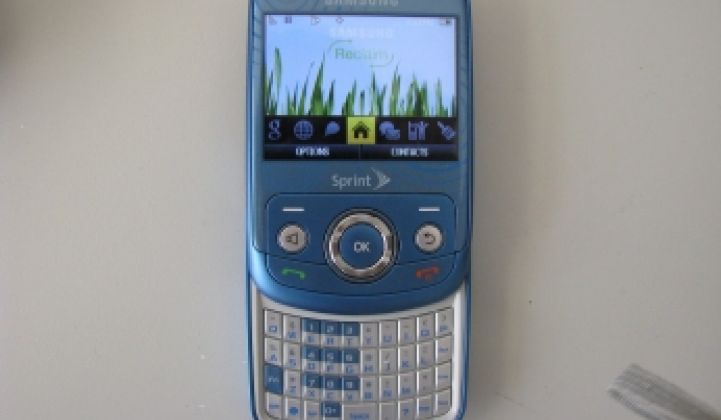Bioplastic doesn't scratch easy.
If you've been considering buying a phone or a laptop made with bioplastic, the good news is that bioplastic (or at least a bioplastic blend) seems to be as durable and hardy as the stuff that comes from the fossil fuel.
Last month, Samsung released the Reclaim, a phone made from 80 percent recyclable materials. And one of the most visible recyclable elements is the pastel blue or green shell, which consists of 40 percent corn-based plastic and no polyvinyl chloride. My daughter and I dropped it, kicked across the floor, and pecked at it with a house key. The phone, for the most part, remained unscathed. With the key, I could see making some marks, but not more marks than I've made on the LG EnV I own. Trying to inflict damage, we figured, is what a product review is all about.
Manufacturers have been somewhat reluctant to adopt bioplastic in their products. Fujitsu has released a few laptops with bioplastic cases, but not pushed them in big numbers. Sony passed on bioplastic on its green phones. Samsung's blend could be a harbinger of a greater trend. If the customer returns and complaints are low, and the costs continue to drop, more manufacturers will adopt bioplastic. Overally, Samsung tends to be an early adopter, so others will take note.
What else did I like:
• The USB key that contains the press release and images of the phone comes in a wood case. Abe Lincoln could have whittled it.
• The Reclaim pretty much functioned like a smartphone. It made calls, it came with a confusing manual and my daughter could watch Hanna Montana episodes on it. That doesn't say much, but occasionally you get phones that do not function well. With one phone I owned, I would invariably dial numbers when I pressed it to my cheek.
• $2 of the $49.99 cost of the phone goes to the Nature Conservancy. (That price includes rebates.)
• The small recyclable box it comes in. Like many people, some of my desk drawers and large parts of my garage are museums for product packaging. Some of it is intriguing, but awfully stupid. A simple cardboard box that can be folded and tossed into the blue bin is great.
• Handy tips on greening one's life. No blockbusters here, but the phone contains interesting, quick reference points, such as what transesterification is. (It's the process of removing esters to turn vegetable oil to biodiesel.) It also focused on vampire power, a good reminder from a company that gives a cell phone recharger with every phone.
What didn't work:
• A history of green included on the phone. The quick green history states that Romans and Greeks began building houses tilted toward the sun in 1200 A.D. Archimedes already harnessed solar thermal power in the second century B.C. and "sun rights" to homeowners were granted under Justinian in the 6th Century A.D. (But a hat tip for including that the Massachusetts Bay Colony passed laws against cruelty to animals in 1644.)
• The manual. Since no one actually reads this, why include 80 or so pages of paper. Sony got rid of the manual on their green phone. Sony also only ships the paint pigments to the assembly plant, not paint, to cut shipping fuel.



